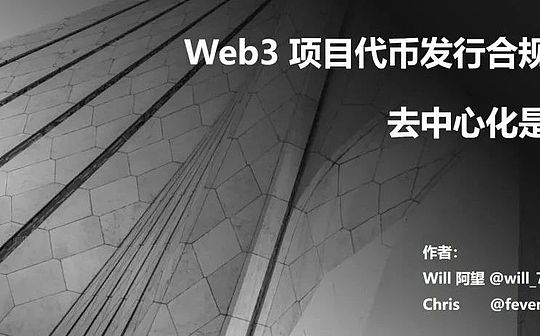
Author: Will Awang, Chris Chuyan
The ultimate goal of most Web3 projects is to issue their own tokens, especially during the crypto bull market, where FOMO sentiment spreads as token prices rise.In this pursuit of “freedom”, the road is rugged, and there will be alarms from unknown dark forests, severe ambush from law enforcement officers, and even prison disasters.
How to issue tokens legally and compliantly is the top priority that Web3 projects need to be clear, but this is far from the end.The end point is to realize the decentralization of the project. Decentralization will not only bring the next healthy development to the project, but also bring more compliance space to the project.
Therefore, this article will explain why decentralization is needed and why decentralization will bring compliance space from the perspective of Web3 legal practitioners and a16z series of articles on decentralization and token issuance, and provide someCompliance strategy aims to provide a preliminary compliance framework for the issuance of Web3 project tokens.
1. Why should we achieve decentralization?
Web1’s Internet was once considered the greatest tool for liberation, until the Web2 platform gradually transformed the Internet into a propeller of centralism, the relationship between network participants and platforms changed from cooperation to competition, and the collective consensus on the Internet also becameThe single consensus of the Internet platform, the once digital utopia became a digital cage until the dawn of decentralized encrypted networks emerged.
As a result, the word “decentralization” has been given too many antidote meanings, whether it is the non-violent confrontation proposal proposed in Crypunk to resist government surveillance censorship, or the programmers achieved through Code is Lawor the political proposition that advocates cyber liberalism.But these are not the main reasons why decentralization is so important for Web3 projects.
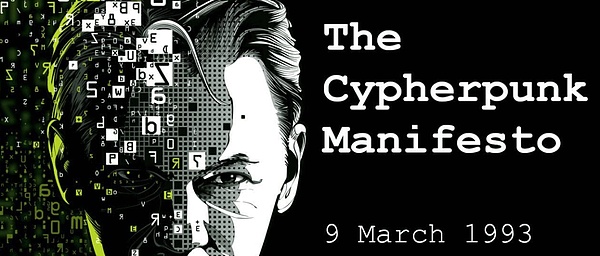
(A Cypherpunk’s Manifesto)
Encrypted networks are decentralized networks built on the Internet. On the one hand, they use consensus mechanisms such as blockchain to maintain and update network status (the collective consensus of Web3 v.s. The single consensus of Web2 platform), and on the other hand, they use cryptocurrency toIncentive to share ownership, co-creation and co-construction of consensus participants and other network ecosystem participants (Web1’s non-profit has no ownership v.s. incentives and ownership of web3 network participants).
And decentralization is a key feature of encrypted networks, which can transfer power on the Web2 Internet platform from closed controlled corporate organizations to open and license-free networks.A truly decentralized encrypted network is more like public infrastructure than proprietary technology and requires strict licensing.
This open, decentralized paradigm shift has the potential to rebuild the Internet in ways that promote competition, protect freedom, protect privacy and fair incentives, and can attract the collaboration of global network participants under appropriate conditions to make the network ecosystem appearExponential growth.This consensus of consistency is one of the main reasons why crypto assets such as Bitcoin and Ethereum continue to ignore skepticism and thriv.
in short,Decentralization means that encrypted networks return data ownership, governance rights, etc. that should belong to network participants to individuals (Ownership), allowing them to work hard to achieve a collective and common goal – the development of the network ecosystem andImproved utility of tokens.
2. Decentralization brings compliance space
Decentralization can not only build collective consensus for projects, allow members to collaborate globally, and enable ecological flywheels to develop, but also bring more space to projects at the legal compliance level.From the starting point of SEC’s regulatory token issuance and the comparison between decentralized ICO and centralized IPO, we can see how decentralization brings compliance space to Web3 projects.
2.1 The starting point of SEC regulation
The biggest “enemy” in the crypto industry is undoubtedly the Securities and Exchange Commission (SEC), which believes that almost all tokens are “securities” and should be registered under the U.S. Securities Act.Since the outbreak of the initial token issuance (ICO) in 2017, tens of thousands of projects have sought to raise funds (including Ethereum) based on their commitment to achieve important technological breakthroughs, but not many projects have truly used funds to implement them.
The SEC attempts to apply the securities law to this simple fundraising behavior, as ICOs are generally able to meet all the conditions of the SEC Securities Determination Howey Test: a contract, plan or transaction in which funds are invested in a common cause,And obtain reasonable profit expectations based on the entrepreneurial efforts of managers or others.
The simplest case is token financing in the primary market (that is, token issuers sell tokens publicly to investors), and this method of public offering will be considered as securities.
In the SEC v.s. Ripple’s financing for the primary market private equity round, the financing for professional investors (Institutional Sales) can also fall into the recognition of SEC securities: (1) money investment; (2) a common cause, that is, Ripple willInvestors’ funds are used for their network operations, and investors’ expected interests are closely related to Ripple’s construction; (3) Obtain the expected benefits through the efforts of others, that is, investors expect to obtain the expected benefits through Ripple’s efforts, and the expected benefits here includethe increase in interest, income, and the increase in the value of the investment target.
In fact, Ripple also informs investors that investing in its XRP tokens may make profits in the future, or linking the value of XRP to Ripple’s own efforts through public publicity in the market.
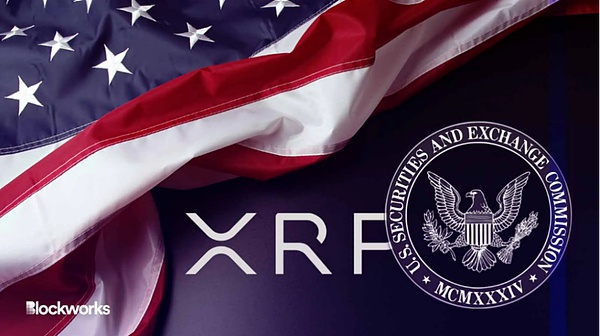
(Interpretation of the SEC v. Ripple case to further clear the fog of supervision)
Despite this position, the fundamental goal of SEC and network participants is consistent, namely, to eliminate information asymmetry and create a level and open competitive environment.
The responsibility of Web3 network participants is to prove that the method of encrypting the network is feasible and can meet regulatory requirements, such as the ability to create a wider range of participants (developers, investors, users, etc.) through a decentralized approach.Level the playing field, use open and transparent ledgers, eliminate single centralized controls, and reduce reliance on management team work.
2.2 Centralized IPO v.s. Decentralized ICO
Let’s first look at the comparison of a simple centralized project IPO listing and decentralized project ICO token issuance, and then look at how the encrypted network can meet regulatory requirements.
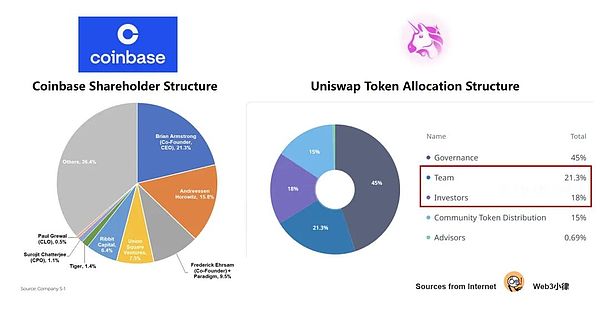
The essence of an IPO is to use a small part of the equity to raise funds for the interests of a small group of shareholders of the company.
As shown in the above figure, the equity structure of Coinbase IPO was in the form of the figure, the founding team and investors accounted for at least 70% of the shares, and the rise and fall of the stock had nothing to do with the users who used Coinbase to trade throughout the day.To be more realistic, you use Coinbase to trade all day long to contribute your performance to Coinbase. What benefits does Coinbase give you?
The essence of ICO token is to publicly issue most of the tokens (can be fundraising or airdrops, etc.), so that Web3 projects will distribute control rights throughout the entire community rather than concentrated in the hands of management teams., thereby decentralizing and promoting ecological development.
The Web3 project development team/management team only accounts for a small part of the token share, and most of the tokens will be used to build the project ecosystem and to incentivize network participants such as early contributors, DApp/protocol users, etc.As shown in the figure above, when Uniswap ICO was launched, only a small part of the development team and investors retained, and the remaining 60% of the tokens were used for the construction and governance of the Uniswap ecosystem.To be more realistic, we can provide liquidity to obtain token incentives, participate in transactions to obtain token incentives, participate in ecological construction to obtain Grants, and so on.
The essence of token issuance is to achieve decentralization, which is crucial for Web3 projects. Otherwise, the project party will fall into the “banker shipment” logic, and the project will not have long-term development.
2.3 Decentralization brings compliance space
From the perspective of decentralization of token issuance, the application of SEC Howie Test is now becoming more difficult: (1) Money investment – token airdrop or other means does not involve money investment; (2) Management teamWork hard – truly decentralized projects do not depend on the efforts of the management team; (3) Profit expectations – secondary market investors do not necessarily need to rely on the efforts of the management team to obtain returns.
At the same time, decentralization can also achieve one of the purposes of SEC – information disclosure.When decentralized projects distribute control throughout the community rather than in the hands of management teams, it ensures that information can reach everyone fairly.
In June 2018, SEC official William Hinman proposed the concept of “Suffiveious Decentralization” in his speech, saying:“If the token or the operating network behind it is sufficiently decentralized, that is, investors no longer expect individuals (or groups) to make necessary management efforts, this asset is not an investment contract.”Based on this logic, Hinman believes that Ethereum does not belong to securities sales because the current Ethereum network is decentralized enough.
It can be seen that decentralization is of importance to US regulation.

(Variant Fund, Sufficient Decentralization, A Playbook for web3 Builders and Lawyers)
3. Token Issuance Compliance Guide
3.1 The degree of centralization determines the degree of project compliance risk
Although decentralization can bring compliance space to projects, the SEC still released the Digital Asset Issuance Framework that keeps pace with the times in April 2019, and continues to expand it in the form of regulatory enforcement.Jurisdictional boundaries over crypto assets (such as regulatory enforcement of Coinbase, Binance, Ripple, Uniswap, etc.).
In any case, in order to avoid trouble from SECs, Web3 projects must try to work within the guidance provided by the SEC to bring more room to compliance (Mitigate Risks).
Similarly, no matter which jurisdiction is in, Web3 projects also require a legal opinion before the exchange token issuance (IEO), indicating that this is a “non-security” token issuance to circumvent the securities laws of the relevant jurisdictions.supervision.
It can be seen that the magnitude of compliance risks borne by a project depends on its degree of decentralization.Fully decentralized Bitcoin is the only crypto asset that is excluded from securities by the SEC, and Ethereum is being tested.
In response, Miles Jennings, head of policy, legal compliance at a16z, made it clear:Decentralization is the only way a project can take to help eliminate risks that securities laws are designed to address.Decentralization is the North Star that provides the ultimate guidance for the project, and other path strategies are expedient.
Of course, the project cannot be decentralized as soon as it starts. Most Web3 projects require a “gradual decentralization” process.
3.2 Exclude any U.S. factors
Most projects do not have the ability to be fully decentralized when tokens are issued, so their tokens themselves theoretically have the possibility of being recognized as securities by the SEC.For example, in the case where the SEC sued Binance and Coinbase, we saw more than a dozen “security tokens” listed by the SEC.In addition, the public issuance of tokens will also be recognized by the SEC as the issuance of securities.
Therefore, the direct way to avoid US regulation (especially the SEC) is to exclude any US factors and leave US regulation without jurisdiction.
Similarly, this method of exclusion also applies to Chinese jurisdictions.
Therefore, when compliance capabilities still need to be improved, the United States should be avoided as much as possible whether it is financing in the private placement stage of the primary market, TGE stage of the token launch, or the token secondary market transaction stage, whether it is necessary to avoid the United States as much as possible.Factors (such as the American public, American investors).
Feasible paths include:
A. Early airdrop incentive stage: Web3 project parties can implement geo-blocking/VPN blocking of US users, making them unable to participate in airdrops, token incentives, and most importantly token public offering funds;
B. Private equity phase: In case of private issuance of tokens to US investors or employees, Web3 projects can still operate under the exemption of SEC Regulation S;
C. Public offering and trading: Issuing tokens through entities located outside the United States and abandoning listing on IEO, a crypto trading platform in the United States, such as Coinbase, Gemini and Kraken.
If in practice, most offshore foundations (such as Cayman, BVI, Singapore) will become the main body of token issuance, that is, tokens are decentralized, then non-profit foundations will govern decentralized projects.Governance rights, and the foundation is an isolated entity without shareholders, there is no conflict of interest, and is focused on the development of the project ecology.
Essentially, if a project does not offer its tokens to Americans, even if it is not “fully decentralized”, the risk of SEC enforcement is greatly reduced.Therefore, any tokens for financing purposes should be avoided as much as possible for the public sale of tokens targeting US factors.
3.3 Restrictions on project operations
Although some of the above strategies can solve the regulatory issues of token financing issuance to a certain extent (such as excluding the US factor), since the Web3 project was born to target the global market and most of it was operated online, the Web3 project party especially needs toAdhere to some restrictions in daily operational activities, especially when talking about the value of tokens (such as social channels such as Discord, Twitter, Telegram, etc.), to avoid falling into the regulatory trap.These activities include:
1. Agreement Development
2. Business Development
3. Marketing Curation
4. Intellectual Property
5. Governance decision-making
3.3.1 Decentralized transformation of project party identity
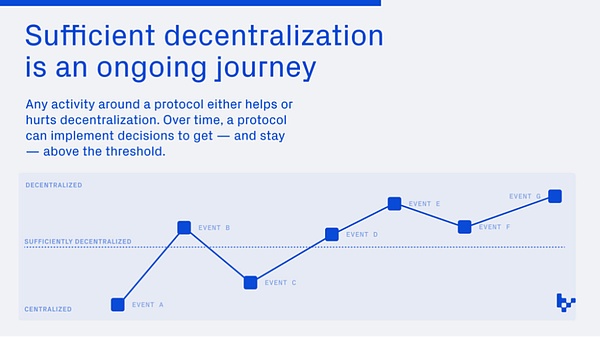
(Variant Fund, Sufficient Decentralization, A Playbook for web3 Builders and Lawyers)
Web3 project parties should avoid several situations before the token issuance and after the token issuance, the project enters the decentralization stage:
A. Before launching a public offering, you should try to avoid discussing or citing your own token value, including potential airdrops, token allocations, or token economics.We have seen that the SEC has previously blocked Telegram’s token offering;
B. At all times, discuss the price or potential appreciation expectations of tokens, or regard them as investment opportunities.This includes reference to any expectations that may lead to the appreciation of the token (such as procedural “burning” tokens to achieve pricing goals or stability), and any commitment to using private capital to continue to fund the development and success of the project;
C. After the token is issued, the project enters the stage of decentralization, and the startup team or management team (including founders, development companies, foundations and DAOs) should clarify their positioning.
Web3 project parties need to use the “initial development team” to replace the former “core development team” or “main development team” and use the “core contributor/contributor” to replace the individual’s previous company’s Title. The foundation and DAO members should use it to replace themselves.Defined as a nonprofit contributor to facilitate the growth of the Agreement/DApp/DAO.
At this point, it is easy for Web3 project parties to fall into a centralized language, even if the projects are extremely decentralized, especially when they are used to talking about achievements, milestones and other releases in the first person.These self-positioning pitfalls include:
-
It should be avoided to imply that one has ownership or control over the Agreement/DApp/DAO (e.g., “As CEO of the Agreement…” “Today, we turned on the X function of the Agreement…”);
-
Avoid commitment or assurance ongoing work in agreement/DApp/DAO and avoid seeing ongoing work as having an excessive importance to the ecosystem;
-
Avoid stressing efforts that have promoted or will promote greater decentralization;
-
Provide your own independent voice to the project’s DAO or foundation to avoid confusion.A better way is to avoid confusing third parties, distinguish the project development company Labs from the subsequent foundation Foundation (such as Ondo Finance and Ondo Foundation, Uniswap Labs and Uniswap DAO), or directly make it not with the agreement.Shared name;
-
Ultimately, what anyone communicates should reflect the principle of decentralization, especially in public places.Communication needs to be open and aimed at preventing any individual or group from producing significant asymmetric information.
The transformation of identity is particularly important. Pay attention to the trouble coming from the mouth and understand that you are no longer the CEO with great power.
3.3.2 Public information acquisition channels
In addition to the things that need to be paid attention to in the daily operation of the project, the Web3 project party should disclose the progress and operation of the project to the public as much as possible, which is exactly the information disclosure required by the SEC.For example, simple and practical methods of public communication are needed, such as public Notion pages, Discord channels, governance proposal voting Forum, Weekly Summary meetings, etc.
In a decentralized encrypted network, since the project code is open source, the key to the success of a decentralized project is how to execute, not how to hold “confidential”.If the project retains “confidential information” without disclosure, this is unfair to investors and will also increase the securities attributes of the token.
3.3.3 Lock-Up Period
In addition, Miles Jennings also mentioned the need to always extend the token lock-up period, at least one year after the token issuance.The SEC has previously successfully exploited the lack of a one-year lock-up period, literally preventing Web3 project parties from issuing tokens.This approach can help alleviate the above-mentioned legal compliance risks, and can also reduce the pressure on token prices to decline due to token selling pressure, and demonstrate confidence in the long-term viability of the project.
Once decentralized, no individual or company will be the spokesperson for the project anymore.The project’s ecosystem is its own, independent and unique.
4. Model of decentralized projects
However, it is difficult for the market to define the complete decentralization of projects, but we can still provide guidance by observing the decentralization paths of some relatively compliant projects in Europe and the United States in the market.
As the most successful decentralized exchange, Uniswap’s growth path is worth learning from, especially involving sensitive cryptocurrency trading business, and is in the context of opaque US regulation.Moreover, Fintech’s compliance is the top priority.
We combed through the compliance path after Uniswap Labs’s stripping protocol, which provides a regulated-friendly decentralized sample for Web3 projects.The purpose of such a divestiture is to achieve gradual decentralization on the one hand, and to gain more room for maneuver at the regulatory compliance level.

A. Decentralized non-security tokens
Uniswap protocol runs independently on the chain, governing through Uniswap DAO, realizing decentralization, and the single functional token UNI governs tokens for it.This model avoids SEC’s securities determination and brings favorable judgments from the court.
B. DAO Legal Packaging Member Limited Liability
Uniswap DAO establishes the legal entity of Uniswap Foundation, which serves as the legal packaging of DAO. On the one hand, it guarantees the limited liability of DAO members, and on the other hand, it can interact with the Web2 world and expand its influence.
C. Labs independent operation Flexible front-end development
The Uniswap Labs team, which previously developed and maintained the agreement, became a separate legal entity and became the main contributor to the agreement. On the one hand, it got rid of the restrictions from the agreement, and on the other hand, it was able to build and maintain front-end products by calling the back-end protocol to achieve sustainability.This way, the Uniswap DApp, which has the charging mode, has been enabled.
D. Regulatory application rather than agreement
Just as the regulatory principle advocated by a16z, decentralized on-chain protocols are just code and are difficult to be compatible with supervision. The front-end applications developed by Labs are fully able to meet regulatory requirements, allowing teams and products themselves to get rid of possible regulatory risks.Just like any app, front-end applications can be included in KYC/AML/CTF verification according to regulatory requirements, remove tokens that have been warned by supervision at any time, apply for license qualifications, etc.
Although on April 10, 2024, Uniswap Labs received a Wells Notice from the SEC, informing the SEC that it may take regulatory enforcement actions such as litigation against Uniswap Labs, it is more about the SEC’s characterization of the nature of its crypto trading business itself, rather than theThe non-compliance of the centralized legal structure.
5. Regulatory barriers in Chinese jurisdictions
The above token issuance compliance strategy is a summary of compliance experience for some leading projects, especially involving a jurisdiction in the United States that is relatively open to crypto assets.For China, a jurisdiction that prohibits any crypto asset activity, token issuance will inevitably come with great risks.
In fact, the essence of supervision in the two jurisdictions is the same. Imagine that in the gray area, the project party earned glittering gold through gray means, and it happened to be seen by some people, and they happened to have “can have” the power of law enforcement.The United States attaches more importance to the rule of law and will use more rule of law to deal with you, and China’s one-size-fits-all attitude shows everything.
Therefore, any reason that law enforcement can be avoided should be avoided as much as possible.

(Web3 Guide to the Conscience of Practitioners—Be sure to protect yourself outside)
5.1 Criminal risks that may be involved in the token issuance process
As we all know, decentralization is a major feature of the Web3 industry, but the project parties operating behind the decentralized project and the actual controllers of the on-chain address are always citizens under legal supervision and constraints, so the project parties issue tokens.In the process, it is necessary to avoid violating China’s legal red lines as much as possible.During the token issuance and financing process, the project party often attracts user investment with high returns, and conducts project promotion online through public Twitter, telegraph and other media channels, and cooperates with the ground promotion team to attract unspecified projects.People promote their projects, and this token financing issuance model is likely to constitute the crime of illegally absorbing public deposits.
The founding team of Web3 project raised huge assets through token issuance in a short period of time. Due to the lack of necessary supervision and its own management of the project’s financial status, the disclosure of funds processing is opaque, which easily leads the project party to use the fundraising for its own purposes.The core members of the team purchase luxury cars or luxury houses or convert them into their own funds to trade currency speculation, which eventually leads to the squandering of funds being squandered and unable to be returned to ecological project construction, which constitutes the crime of fundraising fraud.
In addition, the above mentioned that in the token promotion and distribution process, in order to achieve a high user growth in a short period of time, it is usually carried out cooperation with the ground promotion team and KOL to attract users to purchase the hardware equipment of the project.Cloud computing power obtains profits and adopts recommended development and hierarchical rebates to reward users’ fission during user growth. This model is very likely to constitute the crime of organizing and leading pyramid schemes.
Reference: View the possible criminal risks involved in the coin issuing project through the “Xirtam incident”
5.2 Beware of the harm caused by profit-seeking law enforcement to Web3 projects
At present, local governments in some remote areas have huge financial pressures, and in judicial practice, the profit-seeking law enforcement of Web3 projects is serious. Technology companies investigate clues of case sources and cooperate with public security organs, and for project executives in China and master private keys.Members conduct arrest and investigation, forcibly transfer project tokens or other cryptocurrencies held by the person involved in the case to an address controlled by the public security organs for disposal and cashing.
Normally, all the income from fines and confiscations should be paid to the state treasury, but in judicial practice, a few local governments return the income from fines and confiscations as part or all of the case handling funds to the case handling agencies, so that the cooperative technology companies will also receive a technical service fee..
This is a business model that threatens Web3 projects.
In the above-mentioned law enforcement activities, the investigation by the regulatory authorities on the grounds that the case is involved will inevitably lead to panic and lack of security among project community personnel. The case handling agency will also cause severe fluctuations in the price of project tokens through the secondary market.After the entire project is investigated by the case-handling agency, regardless of whether the final conclusion is suspected of illegal or criminal, the project will be difficult to continue to operate in the future. In the end, the community developers, loyal users and investors will be paid for all this.
Therefore, for Web3 project parties, in the face of the harm that profit-seeking law enforcement may cause to investors and ecological participants, it is necessary to arrange core members of the project such as products and technology and multi-signature managers of project addresses to go overseas.Multi-signature management of project financial addresses to avoid single-point risks and be responsible for the safety of users’ assets.
6. Write at the end
The above framework provides a preliminary compliance path for token issuance for Web3 projects. Of course, different projects will have different compliance points that need to be superimposed, such as the data compliance requirements of DePIN and DeAI projects, RWA and financial compliance of payment projects.Requests, so on, we won’t continue to expand here.Before the project is implemented, please consult your own lawyer, Not Your Lawyer, Do Your Own Research.
This framework is designed to help Web3 project parties to explore token economy, ecological development, and promote project decentralization without having to bear the risks brought by owning tokens.
Of course, not any project will apply. Web3 projects will take time to achieve decentralization, and compliance also requires a corresponding price. Project parties must formulate a well-thought-out script for decentralized operations.








